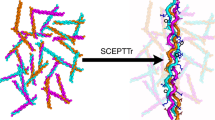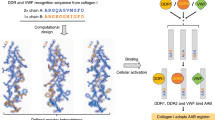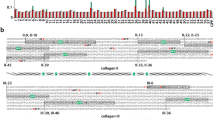Abstract
A TRIPLE helical structure for collagen with two systematic hydrogen bonds for every three residues was put forward from this laboratory in 19551. This structure was criticized by Rich and Crick2 on the basis of a few short interatomic contacts occurring in it; they suggested that only structures with one hydrogen bond for every three residues will be free of bad contacts. Recently, we have examined the whole question carefully, and it has been found that it is possible to build up a two-bonded structure (two hydrogen bonds for three residues) while retaining all contacts within permissible values. This has been possible mainly because a study of the observed interatomic contacts in various reported organic structures showed that contact distances actually occur which are much shorter than those mentioned by Rich and Crick2, namely, C … C = 3.6 − 4.0 Å and C … O = 3.2 − 3.4 Å. In fact, if Rich and Crick's criteria were adopted, some of the accepted structures like the α-helix will become unacceptable. Secondly, the study of the relation between the NH … O hydrogen bond distance and the infra-red frequency showed that the observed frequency (Ramachandran, G. N., Sasisekharan, V., and Thathachari, Y. T., unpublished work) in collagen, which is higher than that observed in other proteins, should correspond to a value of the order of 3.0 Å. The actual parameters of the minor helix of the collagen structure have also been re-determined. These gave a value of 2.95 Å. for the residue height and 3.28, rather than 3.33 (10/3), for the number of residues per turn. As a consequence, the twist for three residues in the triple helical structure should be 30° rather than 36°.
This is a preview of subscription content, access via your institution
Access options
Subscribe to this journal
Receive 51 print issues and online access
$199.00 per year
only $3.90 per issue
Buy this article
- Purchase on Springer Link
- Instant access to full article PDF
Prices may be subject to local taxes which are calculated during checkout
Similar content being viewed by others
References
Ramachandran, G. N., and Kartha, G., Nature, 176, 593 (1955); Proc. Ind. Acad. Sci., A, 42, 215 (1955).
Rich, A., and Crick, F. H. C., Nature, 176, 915 (1955).
Author information
Authors and Affiliations
Rights and permissions
About this article
Cite this article
RAMACHANDRAN, G., SASISEKHARAN, V. Structure of Collagen. Nature 190, 1004–1005 (1961). https://doi.org/10.1038/1901004a0
Issue Date:
DOI: https://doi.org/10.1038/1901004a0
This article is cited by
-
One Hundred Years After the Latimer and Rodebush Paper, Hydrogen Bonding Remains an Elephant!
Journal of the Indian Institute of Science (2020)
-
Synthesis of monomers which are triplets of the ?crystalline? part of collagen molecule
Bulletin of the Academy of Sciences of the USSR Division of Chemical Science (1969)
-
Sekund�r- und Terti�rstruktur von Makromolek�len. II
Die Naturwissenschaften (1968)
-
Deuterium–Hydrogen Exchange of Collagen Like Synthetic Polypeptides
Nature (1967)
-
Untersuchungen zur Struktur des Kollagens
Die Naturwissenschaften (1967)
Comments
By submitting a comment you agree to abide by our Terms and Community Guidelines. If you find something abusive or that does not comply with our terms or guidelines please flag it as inappropriate.



